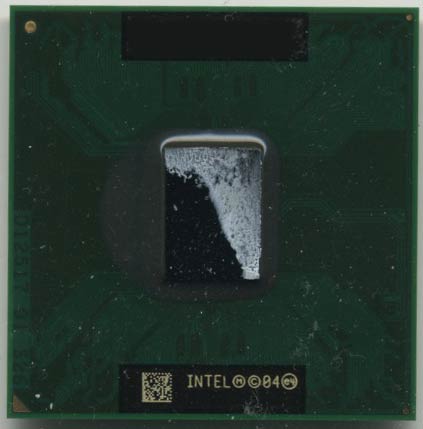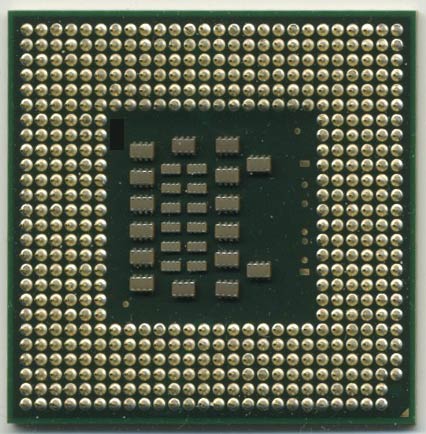Intel Yonah Performance Preview - Part I: The Exclusive First Look at Yonah
by Anand Lal Shimpi on November 30, 2005 2:50 AM EST- Posted in
- CPUs
Intel, oh Intel, how uninteresting your processors have been to us for so long now. Where have the days of the Northwood gone? Prescott brought us a minor bump in clock speed, minor increases in performance, and more importantly - major increases in power bills. But if any company can go down the wrong path for five years and still come out on top, it’s Intel. So starting next year, we’ll start seeing a new Intel. A more power conscious Intel and to kick it all off will be Intel’s first Earth-friendly dual core processor: Yonah.
As the successor to the current Pentium M (Dothan) and the predecessor to next year’s Conroe, Merom and Woodcrest cores, Yonah is a very important chip. As a mobile processor Yonah will bring dual core to thin and light notebooks, basically anywhere you’d find a Pentium M, you’ll now be able to find two Pentium Ms. The implications for mobile performance are huge, as multitasking on notebooks has rarely been all that great of an experience. At the same time, Yonah is so much more than just a dual core mobile processor - it’s a predictor of the performance of Intel’s next-generation desktop micro-architecture. Sure, it won’t have all of the architectural bells and whistles that we’ll see when Conroe debuts at the end of next year, but it’ll have many and that makes it a reference point.
The problem with the Pentium M architecture has been that although it’s traditionally done well at office tasks and obviously in the power consumption department, it has lagged behind the Pentium 4 and Athlon 64 when it comes to FP intensive applications such as video encoding, and to a lesser degree, 3D gaming. With Yonah, Intel has promised to address those performance issues, and even more so with their next-generation micro-architecture later next year. But we tend to want to see things for ourselves, and Yonah will at least give us an indication of how things have improved since Dothan, and whether or not Intel is on the right track to replacing the Pentium 4.
By now we’ve hopefully stressed the importance of Yonah, and there’s just one more detail to mention - we have one.
The Platform - Yet Another Socket
While the launch of Yonah still won’t be until January of next year, we’ve had a chip for the past month, unfortunately, we haven’t had a motherboard to stick it in. We finally got one two days ago, which is why you’re seeing this article now, instead of more pictures of our Yonah posing alongside the Xbox 360. The problem is that Intel seems to have changed sockets once more, meaning that Yonah is not backwards compatible with the original Pentium M socket.

If you’ll remember back to the introduction of the Pentium M, Intel introduced a brand new socket for the processor: Socket-479. Back then, the desktop Pentium 4 still used the pin-based Socket-478, so the different pin-out was a bit of a pain to deal with as we all wanted to be able to stick Pentium Ms in our Pentium 4 motherboards.

The Yonah socket is still a 479-pin interface, however the pin-out has been changed once more, and of course Yonah won’t even physically fit into any current Pentium M motherboards. Instead, you’ll need a brand new motherboard with a brand new chipset. So if you invested in any of the handful of desktop Pentium M motherboards that were released over the past year, you’re unfortunately out of luck.

Yonah (left) vs. Dothan (right) - Note the different pin-out
What’s this about a new chipset? Well, it’s not exactly a new chipset, rather it’s Intel’s mobile 945 chipset - the mobile version of the desktop chipset we’ve had for quite some time now. The platform we’re testing on in particular uses Intel’s 945G chipset, with integrated graphics, but of course we aren’t too interested in integrated graphics performance so we’ll be using the PCIe x16 slot on the board.
While we can’t tell you who makes the motherboard we’re testing with, the important thing to note is that it is a desktop motherboard made specifically for Yonah. It’s got a single PCIe x16 slot, meaning you don’t have to rely on integrated graphics, and all of the bells and whistles you’d expect from a desktop motherboard; this could very well be the heart of your next system.
We’ve been hearing that Pentium M based desktops will become a lot more common next year, and this motherboard is definitely an indication of that.










135 Comments
View All Comments
monsoon - Wednesday, November 30, 2005 - link
i am waiting for overclocking tests and most of all the coming release of a MAC MINI with this baby inside. I'm going to run windows on it if possible ( so does it come with VT or not ? ). Hopefully january won't be a let down from apple...tfranzese - Wednesday, November 30, 2005 - link
Are you dense?Ask yourself: What's the mini's price point? Now, what do you think this chip's price point will be?
I think you're dreaming.
Furen - Wednesday, November 30, 2005 - link
I wouldnt quite put it like that. I think single-core Yonahs will find themselves thrown into the cheaper Mac Minis, I dunno if apple will actually make a premium version with the dual-core CPUs.forPPP - Wednesday, November 30, 2005 - link
I don't understand all those comments that AMD is 2 year ahead because Athlon 64 X2 3800+ is on average 8% faster.Yohan is MOBILE cpu, while Athlon 64 X2 is desktop. Please compare Yohan with Turion and then complain.
Intel has lead with 65 nm technology which means AMD won't catch it up for very long in mobile market. Turion dual core at 90 nm will be far far behind Yohan.
rpsgc - Wednesday, November 30, 2005 - link
Yonah is a 65nm dual-core, Turion is a 90nm single-core....
forPPP - Wednesday, November 30, 2005 - link
[quote]Yonah is a 65nm dual-core, Turion is a 90nm single-core....[/quote]And that's why for now there is nothing to compare. Yonah is its in own class. Even "Turion Dual Core" will be behind it, because of power consumption problem.
tfranzese - Wednesday, November 30, 2005 - link
Really? I can't pick a notebook up today that has one, so comparing a processor that's been shipping for quite some time to this one means little.
Further, no one seems to point it out, but does Yonah not have 64-bit extensions? If not, now that near every desktop CPU sold today has them it'd be a real shame if 64-bit Windows development gained momentum.
forPPP - Wednesday, November 30, 2005 - link
Great point. You are right. It's the biggest disadvantage of the Yonah.
Viditor - Wednesday, November 30, 2005 - link
WHAT power consumption problem?
Shintai - Wednesday, November 30, 2005 - link
Maybe the power problem with adding over twice the transistors.Dothan->Yonah ~140mio to ~151mio ~8% more transistors
Turion->Turion X2 ~105mio to ~233mio(X2 current) ~121% more transistors.
And transistors = powerusage.